Issue 4, May 21, 2018
Rhizosphaera - What It Is, and What It Is Not
Observations of Rhizosphaera needle cast (Rhizosphaera) have been widespread throughout the state for the past several years. As a result, I've been seeing a lot of pictures/videos/articles showing home growers what to look for (and recommending treatment). The issue is, some of those pictures/videos/articles are not actually pictures of Rhizosphaera. They are pictures of a spruce with brown needles, or a video of a spruce with discolored needles, but not likely due to a Rhizosphaera infection. Therefore, I decided to write this article about what Rhizosphaera is, but more importantly, what it is not.
What IS Rhizosphaera Needle Cast
Rhizosphaera is a fungal needle cast, common on blue Colorado spruce in Illinois. Most infections occur during a roughly 2-month period following bud-break. Symptoms, however, do not appear until fall, and are most evident the following spring. Diseased needles develop a characteristic purple or brown color before dropping from the tree. Premature defoliation results in thin, bare branches with only tufts of new needles on the branch ends. Healthy trees have branches with needles that remain attached for several years. Rhizosphaera will generally start low in the tree and advance upward through the canopy over many years. Scout for Rhizosphaera with the aid of a hand lens or microscope. Look for fungal fruiting bodies protruding from the needles' pores. Fruiting bodies have smooth edges and develop in perfectly aligned rows on the needles. Be aware, the disease symptoms and fruiting bodies can easily be confused with Stigminia needle blight.
Rhizosphaera IS:
- Affected needles become dark brown or purple
- Older growth needles are affected
- Affected needles will eventually fall from the branch
- Affected trees will have bare branches with little tufts of new growth at the tips
- The disease usually starts at the bottom of the tree and works its way up
- Mostly found on blue Colorado spruce or other spruce under stress
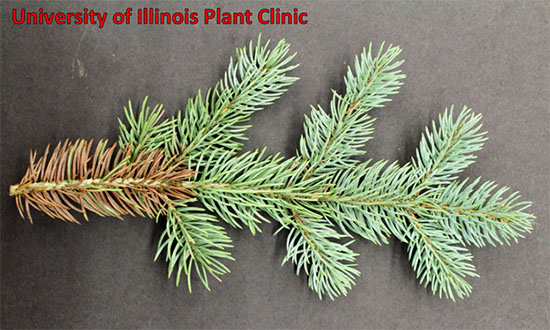
Rhizosphaera IS: note the dark, purple/brown needles of the old growth
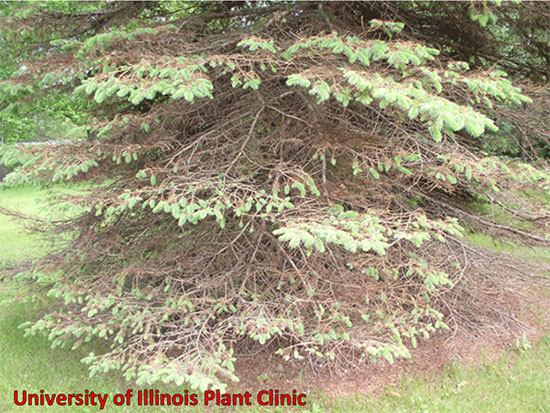
Rhizosphaera IS: note the tufts of green, healthy needles at the tips of otherwise bare branches
What IS NOT Rhizosphaera Needle Cast:
There are many other issues that can cause discoloration of spruce needles, including spider mite feeding, cankers, chemical exposure, and abiotic injury such as winter burn or desiccation. Incorrectly diagnosing these symptoms, and subsequently applying a fungicide to treat for Rhizosphaera will do nothing if the damage is actually due to any of the above. So, take a moment to double-check that the tree is truly infected with Rhizosphaera. The extra effort will help you provide better controls as well as save you money and time.
Rhizosphaera IS NOT:
- Light brown, straw-colored, or yellowing needles
- New growth showing symptoms
- Banding or spotting or stippling of needles
- Exudate or cankers on branches or trunk
- Branches bare to the tips
- Severe defoliation on a white spruce or Norway spruce (Rhizosphaera needle cast does not affect these species, unless the trees are under high stress)
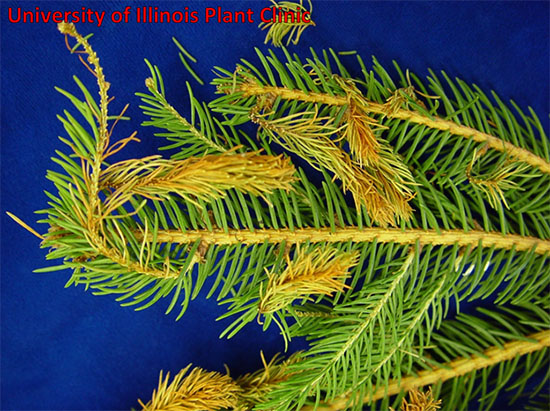
Rhizosphaera IS NOT: note that the affected needles are the new growth, while the old growth appears healthy.
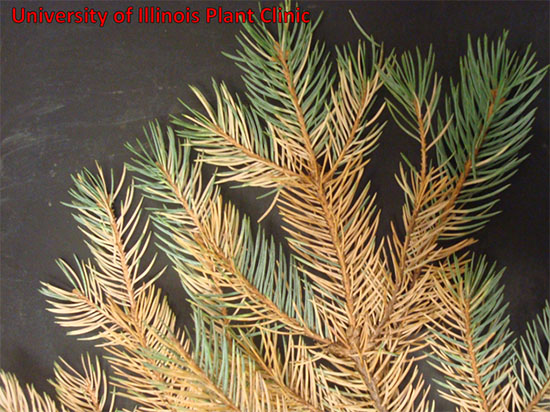
Rhizosphaera IS NOT: note the light brown/straw colored affected needles, and that they're scattered in with the new growth .
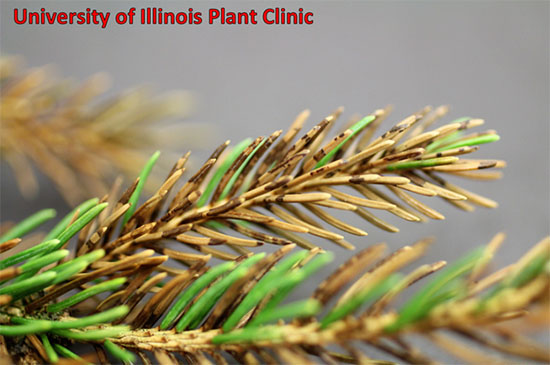
Rhizospheara IS NOT: note the banding/speckling of the needles, and that new growth is affected
Rhizosphaera Needle Cast Management
Management for Rhizosphaera consists of fungicide applications twice a year in spring, usually for multiple years. Fungicides with the following active ingredients are labeled for use against Rhizosphaera: chlorothalonil, chlorothalonil + thiophanate-methyl, copper, and copper hydroxide. Keep in mind that infected and fallen needles will not regrow, so recovery can take many years if the infection is severe. In those cases, removal and replanting with a less susceptible host may be a better option. Trees under stress are more likely to become infected, to reduce stress on spruce by lightly mulching the base of the tree, watering during periods of dryness during the growing season and going in to winter, pruning out dead wood during dry weather, and fertilizing in spring right before new growth expands.
If you're having spruce issues and aren't sure what the cause is, consider sending a sample to the University of Illinois Plant Clinic for pathogen and pest identification. For more information about submitting a sample, please see our website: http://web.extension.illinois.edu/plantclinic/ (Diane Plewa)
Author:
Diane Plewa